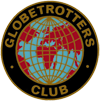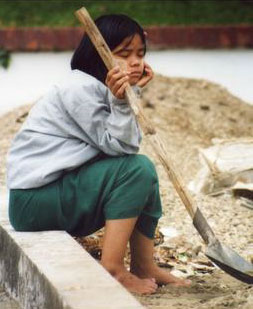The day not long born – Bloody hot already, the sun
reflecting off the tarmac and I could already feel the weight
of the heat on my back and head, even through my Tilley hat.
The fragile looking little single-engined plane, nicknamed in
Brazil a ‘Teko Teko’ because of its resemblance
in sound and vision to a child’s model plane driven by
elastic bands – It stood there and shimmered and glowed in
the sunshine while the temperature had not yet even reached
42 degrees Celsius.
In what seemed like slow motion a fat mechanic slowly hand
pumped fuel into the plane’s tank. The smell of
aviation fuel added itself to the tropical morning smells as
Adam Baines and I stood waiting nervously to load and board
this Teko Teko. Denis, the pilot, stood there in his
beautifully cut, fashionably faded Khaki. This
forty-something, athletic pilot exuded confidence as he
emerged from the cockpit holding a slender glass phial which
he dipped in the fuel tank. Denis looked at the yellow liquid
in the phial against the blue, blue sky. He slowly brought it
to his nose and gently sniffed it and rolled it under his
nose with the concentration of a wine connoisseur. In
Cruzeiro the pilot’s nose makes the final decision
between aviation fuel and anything else that could find its
way into tank!
Denis eyes turned to us, then drifted slowly over our
baggage. He was not in a good mood. We were last minute
passengers with extra weight, forcing him to remove all his
various boxes, destined for different jungle stops and reload
the craft again. On top of that we were going to pay the
$900-00 with travellers’ cheques instead of US dollars
cash. Denis looked us over. I could feel him wondering if the
traveller’s cheques would bounce. He starred at these
two Europeans and he probably wondered if we knew what we
were getting into. I said, “The traveller’s
cheques are paying for the return as well as the outward
journey and, if they bounce; you won’t have to bring us
back. Chief Biraci will vouch for us anyway”. Right he
said, looking at my waistline “Back to the cargo hanger
to get you weighed”. Finally, now having to believe
that I really did weigh 85 Kilos, we approached the plane
again.
Instrument checks done, the tower gave us clearance, chocks
away. Propeller whirling, he shouted above the engine in
English, let us sway. Mystified for a moment, then Denis
loudly said the Lord’s Prayer in Portuguese and asked
for the Lord to watch over our journey. A moment of reality
came through the excitement and I prayed to whatever gods are
up there, please keep an eye on us. The plane slowly surged
forward, gathering speed, it lifted off and skimmed above the
trees. Cruzeiro gradually disappeared behind us. At last, the
adventure was to begin as we soared up, up and away.
I saw a carpet of green under the sky blue canopy, the sea of
endless forest stretching as far as the eye could see to the
edges of the horizon. I had a feeling of how small and
insignificant are men in comparison to this wonder of nature.
We flew on, gradually leaving behind the amazing golden
beaches of the snaking river Jurua, so different from any
riverbank I had come across before in either Africa or
Australasia.
I was sitting in the seat by the pilot with my camera at the
ready. Ready for what? I looked down at the trees so tightly
packed together, my imagination was running away with the
thought of what might happen if our one motor took sick and
died. Chief Biraci had said, “There are no bad old
pilots in the Amazon. Bad pilots die young; and so do their
passengers”. Quickly glancing round I saw Adam starring
out of the window, obviously moved by the sight of such
beauty. Not the time to spoil his dream with a possible
nightmare, for at that moment a rainbow appeared across the
jungle and made what was already wonderful, magical. I looked
at the Chief relaxed in his seat. I began to feel some of
passion he had for his home, and also began to understand how
he stood up at a conference in Panama and caused
consternation by tearing up a prepared speech while shouting,
“The Yawanawa want their land back”.
This man, who had lived on the building sites of Rio Branco
and earned a pittance of money, had not only fed and clothed
his body, but also fed his mind and soul and to become a
survivor. At a time when most Indians ended up on the bottom
of the human scrap heap, became alcoholics and the low life
of the gutters of these fifth world towns. Chief Biraci had
educated himself, fought for Indian rights to become their
spokesman at the various conferences that became fashionable
in the 80’s when the 1st world became aware of
environmental issues. This plane journey was giving Biraci a
small escape from his almost constant responsibility for the
tribe. We had been in the air now for about 75 minutes, a
journey that would have taken about fifteen days on foot or
twenty by canoe.
Denis, the pilot, banked the plane and we moved on to another
compass heading. He shouted over the roar of the engine in as
much of a conversational tone as possible, “Don’t
forget to be back on the grass strip on the date we agreed.
We were cutting it fine by planning to be back just a couple
of days before the start of the rainy season and the plane
would be unable to land if the strip was waterlogged. I had
already had a bad landing on a previous trip on a water
soaked landing strip, the plane had tipped up on its nose
– So, I had been there, done that and had no desire to
repeat the excitement. “I make two passes and then I
leave – That’s the deal”. I shouted back to the
pilot,” I won’t forget, nor will Adam we both
know that a seventeen day walk as the wet season starts could
be the end for us”. Denis smiled,”Could be? It
definitely would be”. “Thanks for the vote of
confidence”, I shouted. We banked again and Denis said,
“Sete Estrellas, time to land”. We swooped down
low, crossing the river Gregoria and making for the grass
strip by the side of the small group of thatched huts that
was the village of Sete Estrellas and the jumping off point
for our trip into the unknown.

 As part of our
time there we went to see a local group of women rehearsing
traditional Mozambique song (see picture, left). We were
merely walking by when we were invited to sit in on the group
during practice. Listening to the women and drums as the sun
set and the tide came in really will be a lasting memory of
my time spent in East Africa. Later that day we caught a dhow
(traditional African/Arabic sail boat) from Palma all the way
back to Mikindani. This again will stay with me for the rest
of my life as one of the most authentic experiences of the
lives people lead in this part of the world. These sorts of
experiences, however overused the cliché may be,
really are priceless. Money cannot buy memories and certainly
looking at the people of Palma or Mikindani, plays no part in
happiness or generosity. This sort of journey, away from the
beaten track and reach of the guidebooks is highly
recommended and, although not to everyone’s taste, will
provide lasting memories to anyone willing to embark on
them.
As part of our
time there we went to see a local group of women rehearsing
traditional Mozambique song (see picture, left). We were
merely walking by when we were invited to sit in on the group
during practice. Listening to the women and drums as the sun
set and the tide came in really will be a lasting memory of
my time spent in East Africa. Later that day we caught a dhow
(traditional African/Arabic sail boat) from Palma all the way
back to Mikindani. This again will stay with me for the rest
of my life as one of the most authentic experiences of the
lives people lead in this part of the world. These sorts of
experiences, however overused the cliché may be,
really are priceless. Money cannot buy memories and certainly
looking at the people of Palma or Mikindani, plays no part in
happiness or generosity. This sort of journey, away from the
beaten track and reach of the guidebooks is highly
recommended and, although not to everyone’s taste, will
provide lasting memories to anyone willing to embark on
them.
 The fact is that the
call for a tourism boycott comes from Burma's elected
leaders. The National League for Democracy (NLD), who won a
landslide victory in Burma's 1990 election, remains the
only party mandated to represent the Burmese people and it is
a party that continues to draw the support and respect of
people inside and outside the country. Burma's Government
in exile, the National Coalition Government of the Union of
Burma (NCGUB), supports the boycott and it is a position that
has the backing of exile Burmese democracy groups around the
world.
The fact is that the
call for a tourism boycott comes from Burma's elected
leaders. The National League for Democracy (NLD), who won a
landslide victory in Burma's 1990 election, remains the
only party mandated to represent the Burmese people and it is
a party that continues to draw the support and respect of
people inside and outside the country. Burma's Government
in exile, the National Coalition Government of the Union of
Burma (NCGUB), supports the boycott and it is a position that
has the backing of exile Burmese democracy groups around the
world.
 The article also fails to mention
that in Burma many human rights abuses are directly connected
to the regime's drive to develop the country for
tourists. Throughout Burma men, women and children have been
forced to labour on roads, railways and tourism projects;
more than one million people have been forced out of their
homes in order to 'beautify' cities, suppress
dissent, and make way for tourism developments, such as
hotels, airports and golf courses. And these abuses are not
confined to history. In February 2004, for example, Burmese
soldiers rounded up ethnic Salons, or 'sea gypsies'
who normally live on boats in the Mergui Archipelago, forced
them to live on land and to take part in a 'Salon
Festival' aimed at foreign tourists.
The article also fails to mention
that in Burma many human rights abuses are directly connected
to the regime's drive to develop the country for
tourists. Throughout Burma men, women and children have been
forced to labour on roads, railways and tourism projects;
more than one million people have been forced out of their
homes in order to 'beautify' cities, suppress
dissent, and make way for tourism developments, such as
hotels, airports and golf courses. And these abuses are not
confined to history. In February 2004, for example, Burmese
soldiers rounded up ethnic Salons, or 'sea gypsies'
who normally live on boats in the Mergui Archipelago, forced
them to live on land and to take part in a 'Salon
Festival' aimed at foreign tourists.
 A walk around
Mikindani shows little evidence of current military activity
but the historical signs are more common. The Mtwara airstrip
was an RAF base, the customs house was destroyed by naval
artillery and subsequent neglect, the splendid hotel is a
fortified building. The Boma is no great castle but would
have been a hard nut to crack. The crenulations (saw teeth
type things you get at the top of castles) on the bastion at
the back are wide enough to accommodate the large water
cooled barrel of the Maxim machine gun whilst those on the
tower could only fit a rifle. Both employed at the time of
construction.
A walk around
Mikindani shows little evidence of current military activity
but the historical signs are more common. The Mtwara airstrip
was an RAF base, the customs house was destroyed by naval
artillery and subsequent neglect, the splendid hotel is a
fortified building. The Boma is no great castle but would
have been a hard nut to crack. The crenulations (saw teeth
type things you get at the top of castles) on the bastion at
the back are wide enough to accommodate the large water
cooled barrel of the Maxim machine gun whilst those on the
tower could only fit a rifle. Both employed at the time of
construction.